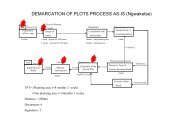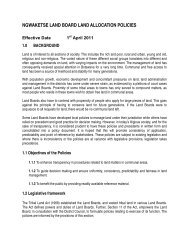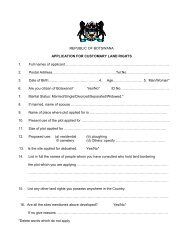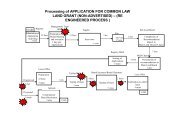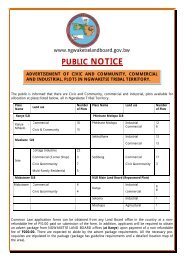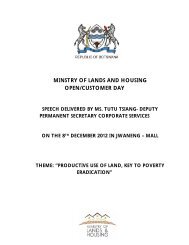District Intergrated Land Use Plan - Ngwaketse Land Board
District Intergrated Land Use Plan - Ngwaketse Land Board
District Intergrated Land Use Plan - Ngwaketse Land Board
Create successful ePaper yourself
Turn your PDF publications into a flip-book with our unique Google optimized e-Paper software.
SOUTHERN DISTRICT INTEGRATED LAND USE PLAN<br />
3 PHYSICAL ENVIRONMENT AND ITS<br />
COMPONENT SYSTEM OF RESOURCES<br />
3.1 THE IMPORTANCE OF THE PHYSICAL ENVIRONMENT<br />
3.1.1 The physical environment is a summation of climatic subsets of rainfall, temperature, wind,<br />
evaporation and evapotranspiration, humidity, solar radiation and physical elements namely:<br />
topography, hydrology, hydrogeology, geology and soils.<br />
3.1.2 The state of the physical environment is an important determinant of the distribution of fauna<br />
and flora in the district. It determines the land use activity system and the nature of<br />
development activities being undertaken across the district. The physical environment<br />
provides the land for land use activities to take place, it provides a set of resources to be<br />
exploited and conserved, natural functions to be maintained and hazards to be avoided for<br />
sustainable utilisation of land.<br />
3.1.3 There is a higher population density and settlement development in the eastern part of<br />
Southern <strong>District</strong> with a significant decrease in population density and sparse settlement<br />
development to the west. This is as a result of the hospitable physical environment which<br />
offers good conditions for human habitation, settlement development and exploitation of<br />
natural resources in the eastern part of the district. On the other hand, the western part of the<br />
district is less attractive to the population and settlement due to a less favourable physical<br />
environment.<br />
3.1.4 Southern <strong>District</strong> has a semi-arid sub-tropical climate with summer rainfall between November<br />
and March. There is a high spatial variation of rainfall from east to west where a higher<br />
average rainfall is received in the eastern part of the <strong>District</strong>. As a result, the eastern part is<br />
suitable for most development activities with the result that there are more development<br />
pressures, competition and conflicts between land use activities in the east.<br />
3.1.5 Rainfall received in the <strong>District</strong> does not only have a high spatial variation, it results in the<br />
accumulation of insignificant surface water resources and has limited distribution to<br />
groundwater recharge. Subsequently, groundwater resources become an important source of<br />
water supply necessitating that land use planning take cognizance of the need to preserve<br />
and protect aquifers from pollution. At the same time limited groundwater recharge has<br />
implications for the security of groundwater resources as a source of water supply in the long<br />
term where there is more groundwater abstraction than replenishment.<br />
3.1.6 The district has environmentally sensitive and fragile areas that require sustainable<br />
exploitation and protection from the harmful effects of wanton resource utilisation. In<br />
particular, settlement development and the discharge of pollutants such as from sanitation<br />
facilities, constitute a threat to groundwater pollution considering that the <strong>District</strong> largely<br />
depends on on-site sanitation systems. The rugged topography in the eastern part of the<br />
<strong>District</strong> is particularly vulnerable to water erosion and when adequate environmental<br />
protection measures are not put in place land degradation is likely to escalate. Wanton<br />
destruction of vegetation through human activities and overgrazing is inclined to cause<br />
material range and land degradation.<br />
3.1.7 The physical environment provides opportunities for development such as in the eastern part<br />
where there is higher rainfall and fertile soils. It may however, constitute a constraint to the<br />
use of land as in areas with hilly terrain and steep slopes, rocky ground, collapsible and<br />
24 REPORT OF SURVEY



